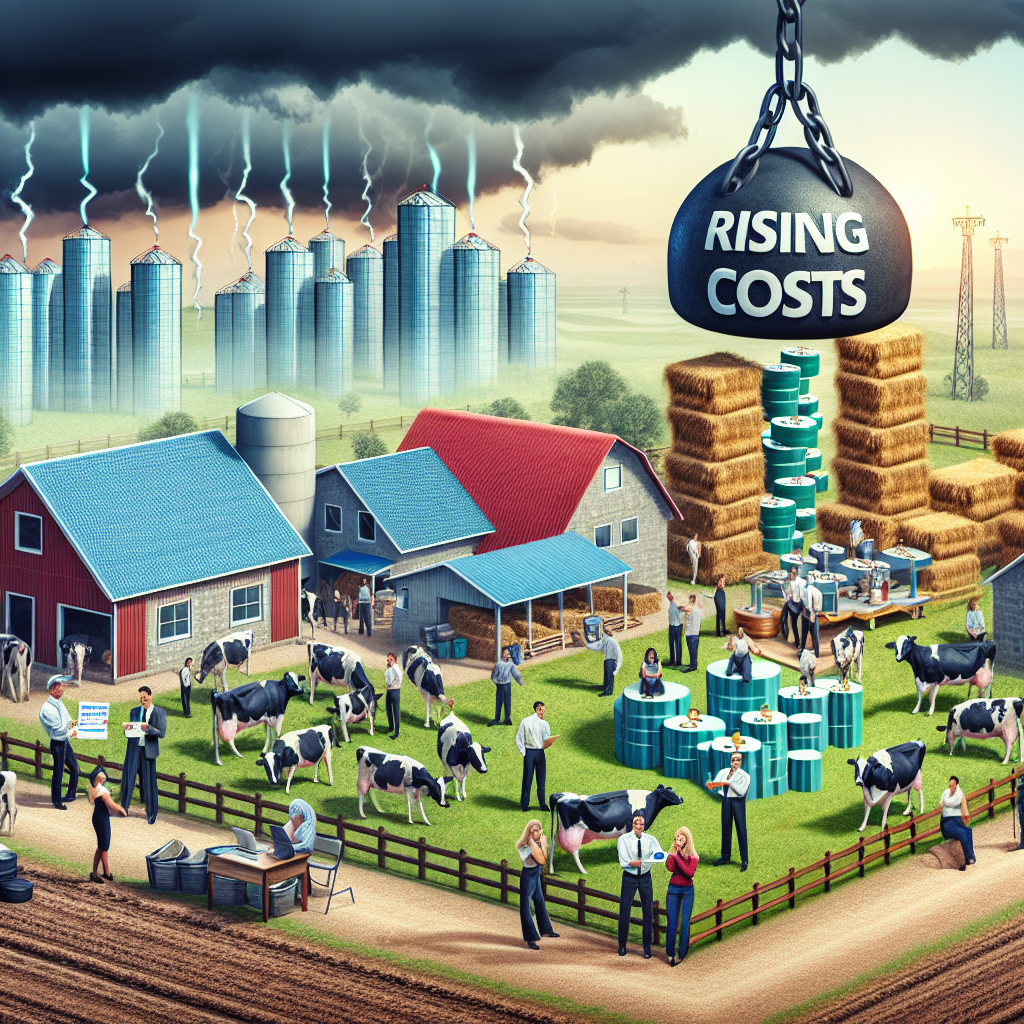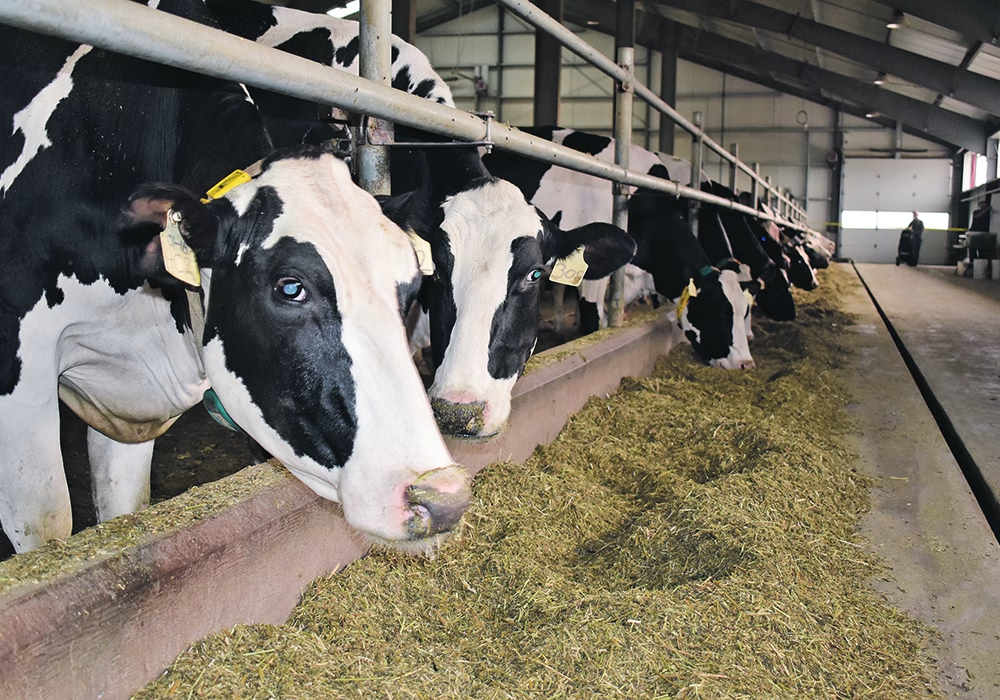Discover how rising feed, fuel, and input costs are squeezing dairy farm profits. Can farm managers navigate these financial challenges to stay afloat?

The financial issues confronting dairy production, notably the rising expenses of feed, gasoline, and other necessities, have reached a tipping point. These farms contribute significantly to the economy and are now under unprecedented strain and need fast and intelligent responses. Rising manufacturing costs jeopardize profitability and sustainability and the industry’s survival. Dairy farms, critical to nutritional food, rural economies, and the agricultural supply chain, cannot afford to overlook these expenditures. Your participation is crucial as we investigate the reasons and possible solutions to alleviate these effects on farm managers. Tackling these financial difficulties is not just necessary; it is essential to the industry’s existence, and your contribution is crucial.
| Year | Feed Costs (per ton) | Fuel Costs (per gallon) | Labor Costs (per hour) | Energy Costs (per kWh) |
|---|---|---|---|---|
| 2020 | $200 | $2.50 | $12.00 | $0.10 |
| 2021 | $210 | $2.70 | $12.50 | $0.11 |
| 2022 | $230 | $3.00 | $13.00 | $0.12 |
| 2023 | $250 | $3.20 | $14.00 | $0.13 |
Unraveling the Multifaceted Escalation of Production Costs
The rise in manufacturing costs is not a simple, isolated issue. It’s a complex interplay of interconnected factors that threaten the financial stability of dairy farm managers. The surge in feed costs, driven by volatile grain markets and increasing demand for agricultural products, is just one aspect of the problem. Global oil price fluctuations and regional supply chain disruptions further inflate gasoline costs. These issues have widespread implications for agricultural operations, impacting everything from transportation expenses to operational efficiency and timely delivery. This intricate web of factors underscores the complexity of the problem and the need for a comprehensive approach to resolve it.
Labor costs complicate the financial picture. The dairy business confronts difficulties in obtaining competent staff, which leads to increased pay and benefits, increased operating expenses, and reduced financial flexibility.
Equipment maintenance is another critical area where costs are on the rise. Investing in new technology and repairing aging equipment is essential to remain competitive in a global market. Dairy farm managers must navigate the balance between immediate operational needs and strategic investments for future stability and growth, underscoring the importance of long-term planning in the face of financial challenges. This strategic foresight is crucial for the industry’s survival.
Feed Expenses: The Cornerstone of Dairy Farm Economics
The most noticeable consequence of growing prices on dairy farms is feed expenditures. Feed components such as grains and forages are volatile because of fluctuations in supply, adverse weather, and international trade restrictions. Fluctuations in feed prices lead dairy farm managers to reconsider purchase tactics and explore other feeding options. For example, a rapid increase in grain prices may significantly increase operating costs, putting pressure on profit margins. This financial strain makes it difficult for farmers to balance flock health and long-term budgeting. This dynamic highlights the critical necessity for decisive government intervention to alleviate the impacts of volatile market circumstances.
The Unrelenting Rise of Fuel and Energy Costs: A Threat to Dairy Farm Sustainability
Dairy farms have high fuel and energy expenditures, which impact daily operations and financial stability. Rising fuel costs significantly increase transportation and machinery-related expenditures, making every dollar saved critical for survival. The transportation of feed and key supplies, essential to farm logistics, is particularly affected by gasoline price increases. When fuel prices rise, transportation costs rise, inflating the entire cost of livestock maintenance and causing a ripple effect that raises operating expenditures across the production and distribution stages.
Dairy farms rely heavily on equipment, from milking to feed processing. The energy needed to operate this equipment is critical to productivity. However, increasing energy rates raise the cost of running this technology, putting additional demand on managers who must balance efficiency and cost-effectiveness. For example, a mid-sized farm that uses tractors, milking equipment, and feed mixers spends much of its budget on fuel and energy. Financial constraints may restrict expenditures in herd health and facility renovations, resulting in difficult decisions such as lowering herd size or deferring infrastructure improvements. This may impair long-term sustainability.
Furthermore, examining expenditures across an animal’s lifespan up to the fourth lactation reveals a significant correlation between growing energy prices and increased production expenses. This emphasizes the need for intelligent energy management and policy actions to offset the effect of rising fuel and energy prices.
Navigating the Conundrum of Escalating Labor Costs
The rise in labor expenses is a big challenge for dairy farm management. Wage rises, driven by minimum wage legislation and market pressures, encourage farmers to invest more in employee remuneration. A continuous labor shortage exacerbates the pressure, necessitating overtime compensation or costly temporary workers to run everyday operations. Furthermore, legislative developments such as harsher overtime regulations, improved safety standards, and obligatory benefits drive up labor costs. Rising labor expenses limit profit margins, forcing farm managers to explore new solutions to enhance productivity and efficiency, critical for their farms’ economic survival in today’s competitive market.
The Financial Labyrinth of Equipment Maintenance and Upgrades
Maintaining and improving dairy farm equipment is a significant financial burden for farm management, involving original and continuing costs. Modern dairy farming relies on sophisticated technology, such as milking robots and feed mixers, which need frequent maintenance to operate efficiently. Maintenance expenditures include periodic servicing, repairs, and replacement components. Repair expenses climb as equipment ages, putting further burden on finances.
Technological innovations boost efficiency and yield but come at a high cost. Upgrading to the most recent models necessitates significant financial expenditure, which is difficult when milk prices vary, and profit margins are tight. The necessity for ongoing investment to stay competitive adds to economic pressure, necessitating tough decisions between modernizing equipment and controlling existing operating expenses.
Maintenance parts and new equipment expenses have risen in tandem with inflation, limiting financial flexibility even further. Supply chain interruptions have also raised expenses and created delays, which might disrupt operations. Thus, the economic problems of equipment maintenance and improvements influence liquidity and long-term viability for many dairy farms.
The Economic and Policy Enigma: Navigating Trade Policies, Subsidies, and Market Dynamics
The more significant economic and policy climate significantly impacts dairy farm operating dynamics, affecting production costs and market viability. Trade rules, subsidies, and market circumstances combine to create a complicated terrain that dairy farm managers must navigate with ability.
Trade policies have a direct influence on dairy producers. International trade agreements and tariffs may either help or hurt the competitive position of local dairy products on the global market. Preferential trade agreements may reduce tariffs on imported feed, lowering costs, but protectionist policies may restrict market access for dairy exports, limiting income possibilities.
Subsidies dramatically affect dairy producers’ cost structures. Government subsidies for feed, energy, and direct financial help may provide critical relief, allowing for investments in efficiency-enhancing technology or serving as a buffer during economic downturns. Reduced subsidies, on the other hand, might significantly raise production costs, putting farm viability at risk.
Market circumstances, driven by more significant economic trends such as inflation and economic development, significantly impact manufacturing costs. Inflation raises the cost of raw materials, labor, and other inputs, while economic downturns may cut consumer spending on dairy products, reducing profit margins. Market volatility creates additional unpredictability, affecting financial planning and budgeting.
The economic and policy environment is a complex tapestry of interrelated elements affecting dairy farms’ production costs and profitability. Understanding and adjusting to these factors is critical for dairy farm managers seeking operational resilience and a competitive advantage in a shifting market.
Innovative Strategies and Tactical Planning: A Multilayered Approach to Addressing Escalating Costs
Addressing rising dairy farming expenses requires a diversified strategy that combines innovation with strategic planning to maintain operational efficiency and profitability. Implementing innovative technology is critical; for example, robotic milking machines minimize labor expenses while increasing milk production efficiency. These systems help to simplify processes and allocate resources more effectively. Optimizing feed efficiency is also essential. Farm managers may improve animal health and production using precision feeding and sophisticated nutrition analytics while reducing waste and feed costs. This strategy reduces input costs while improving animal well-being, contributing to a more sustainable agricultural paradigm.
Exploring alternate energy sources is critical for controlling growing fuel and energy costs. Renewable energy alternatives like solar panels or biogas generators may drastically lower operating expenses. These sustainable energy measures provide long-term financial rewards while reducing the farm’s environmental impact.
Building solid ties with suppliers and looking into bulk buying alternatives may result in considerable cost savings. Participating in cooperative agreements or group buying groups enables dairy farmers to negotiate better pricing and conditions, thus increasing their competitive advantage. Finally, farm managers and personnel get ongoing education and training on the most recent industry developments, ensuring agility in reacting to changing economic challenges. Investing in knowledge and skill development promotes a culture of efficiency and adaptation, which is essential for navigating contemporary dairy production’s intricacies.
Looking Ahead: Navigating the Future of Dairy Farm Economics
Looking forward, the dairy farming industry’s production cost trajectory provides possibilities and challenges, each with significant consequences for sustainability and profitability. Additionally, advances in agricultural technology, such as precision farming and tailored feed, offer increased resource efficiency and cheaper prices. Government actions that promote sustainable practices may help reduce financial constraints via subsidies or tax exemptions, resulting in a more resilient economic climate for dairy producers. Enhanced communication throughout the supply chain, aided by digital advances, may improve operational efficiency and minimize waste, resulting in cost savings.
In contrast, increasing global fuel costs, workforce shortages, and severe environmental rules may worsen financial hardship. Trade policy and market volatility have the potential to destabilize export margins and increase operating costs. Many dairy farms may struggle to remain profitable without enough financial flexibility, perhaps leading to industry consolidation or liquidation.
The future of dairy farming will, therefore, be determined by the industry’s capacity to innovate, adapt, and capitalize on government assistance and market possibilities. Balancing these dynamics will be necessary for remaining competitive in a changing agricultural environment.
The Bottom Line
Rising feed, fuel, labor, and equipment expenses threaten dairy farms’ viability and profitability. This paper investigated these increasing expenditures, examining everything from feed costs to gasoline prices. We’ve also looked at labor costs, equipment upkeep, and the economic implications of trade policies and market volatility. Innovative methods and tactical preparation are required to combat these cost increases. Implementing sustainable techniques, lean management, and financial agility are critical to competitiveness. Dairy farm managers must be proactive and prepared to tackle economic challenges to achieve long-term success. Success in this competitive climate requires a proactive and educated approach. Dairy farms may transform obstacles into opportunities by using all available methods. We must push for policies and solutions that strengthen dairy farms’ resilience, guaranteeing their long-term viability and profitability.
Key Takeaways:
- The rising costs of feed, fuel, and other inputs are significantly challenging the profitability of dairy farms.
- Operational expenses are directly impacted by increasing production costs, putting pressure on farm managers.
- Innovative strategies and tactical planning are essential to mitigate the financial strain on dairy farms.
- Navigating fluctuating commodity prices, evolving market demands, and policy changes are critical for the future stability of the industry.
- Sustainable practices and lean management techniques could offer potential solutions to counteract escalating costs.
- Immediate interventions are necessary to bridge the widening gap between costs and returns, ensuring economic feasibility.
Summary:
Dairy production faces financial challenges due to rising expenses of feed, gasoline, and other necessities, which threaten profitability, sustainability, and industry survival. Volatility in feed costs, supply fluctuations, adverse weather, and international trade restrictions make it difficult for farmers to balance flock health and budgeting. Rising fuel and energy costs increase transportation and machinery-related expenses, making every dollar saved critical for survival. Dairy farms rely heavily on equipment, but increasing energy rates increase the cost of running this technology, putting additional demands on managers. Wage rises and labor shortages further exacerbate the financial burden on dairy farms, with equipment maintenance and upgrades being a significant financial burden.














